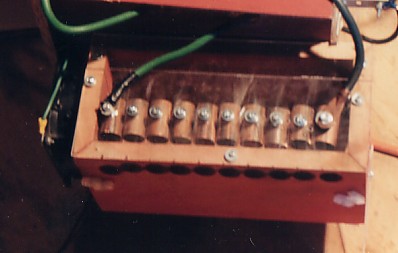| Here is a pic of my spark gap; it is fully adjustable and has nine gaps made of 3/4 inch copper pipe coupling<they have dimples in the center for easy drilling>. It is made for 12000V and my caps will just fire it when it is set wide open. Simply turning one of the screw heads will decrease the gap size. Also, the leads can be easily moved down.The gaps can be cleaned while still on the plexiglass<use 1/4'' or thicker--you can see the stress marks on mine. A 125 cfm fan from Hosfelt pulls enough air to quench well and keep the copper fittings cool to the touch even after 10 min of run time at 760 watts<that's no exaggeration; they are cool after ten min at 760 watts of transformer power>. The air is only pulled between and through the fittings so little is wasted. I know it looks a little rough but this was originally a different kind of gap with air pulled through the top. This did not work nearly as well as the fittings would heat up and reduce preformance. The arc marks you see are from the use of these fittings in the old spark gap. The new one does of course build up carbon after heavy use but this is not visible. |

